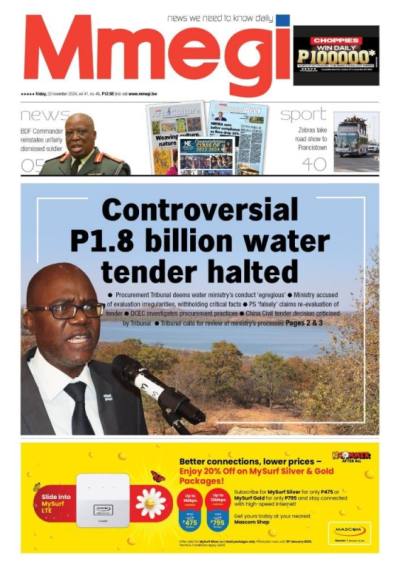The recent national outrage over declining government savings, belies a longer trend of declining budget revenues and slowing growth that predates the COVID pandemic. The recent debate has at least propelled a long-simmering crisis into the public sphere. MBONGENI MGUNI & TIMOTHY LEWANIKA write
No one who has been diligently following the fiscus for any reasonable amount of time, was taken aback by the screenshot that went viral on social media recently. The snapshot, taken from a recent economic update by Econsult, showed that the Government Investment Account (GIA), which represents government’s savings, had dropped from P19.1 billion in July 2023 to P5.1 billion in April 2024, “a drop of P14 billion in only nine months”.
“Clearly this rate of depletion is unsustainable,” researchers at Econsult, who include former deputy Bank of Botswana governor, Keith Jefferis, said in the update.
With a general election due in two months’ time, the issue was unsurprisingly seized upon, with commentary from all sides flying in thick and fast. As the blamestorm and social media disinformation spiralled, Finance Minister, Peggy Serame, was forced to address the issue in parliament and respond to questions from concerned lawmakers.
Serame, in her address, called for calm and reassured that government was not flying off a fiscal cliff, with coffers running bare and pandemonium reigning in the Finance ministry.
“The ministry therefore, wishes to allay any fear that government spending is reckless,” the minister told legislators.
“The reduction in GIA has been due to the financing of the imbalance between low revenues and high expenditure commitments much of which have been aimed at addressing the country’s pressing development needs and stimulating economic growth.
“Notwithstanding this, government remains fully committed to its fiscal consolidation programme as well as rebuilding the relatively low fiscal buffers to sustainable levels.”
As legislators pummelled her with more questions, expressing their incredulity with her responses and as the debate turned decidedly political, Serame hit back.
“If the economy is not doing well, it affects all of us so I don’t understand why some would be celebrating,” she said.
In fact, the economy has not been doing well for some time and the numbers that are more worrying than the GIA’s latest levels, started before Serame’s tenure and even before the Masisi administration came into office.
The more worrying figures can be found in the statistical section of each Bank of Botswana annual report from stretching back nearly a decade ago as well as in each monthly update since then.
The country’s budget, or government’s financial statement of how much it receives and how much it spends, has been running shortfalls since the 2017-2018 financial year. Essentially this means since that time, the government has been spending more than it receives or makes, a situation that has meant a need for more withdrawals from its reserves housed in the GIA, as well as higher borrowings from the local capital market and external financiers.
Fiscal stability is critical to sustainable growth and development, particularly as the country attempts to lift more citizens out of poverty and transform from its reliance on mining and diamonds in particular. Prolonged deficits, such as have been occurring in recent years, drain government’s reserves and force it into more frequent and costlier borrowing, while making measures such as tax increases inevitable. Ratings agencies, whose assessments determine the interest Botswana will have to pay on any external loans it seeks, have been increasingly expressing concern about fiscal stability.
The numbers
According to historical data from the central bank, by June 2014, the GIA was measured at P32.4 billion, dropping to P22.1 billion five years later in June 2019. This week, BoB figures showed that the GIA had hit a historic low of P2.82 billion in June 2024 – another five years later.
During the intervening years, the GIA has swung to highs such as the post-pandemic peak of P18.6 billion and lows such as the pandemic nadir of P3.3 billion in December 2020.
The budget has followed a similar path of general weakening, with estimates that budgets during the National Development Plan 11, which ran from April 2017 to March 2023, incurred a cumulative deficit of P43.4 billion.
The Transitional National Development Plan, which took over from NDP 11 in April 2023 and will end in March 2025, was due to carry cumulative deficits of P12.7 billion over the two fiscal years.
Instead, in her February budget speech, Serame estimated the deficit for the first year, 2023-24, at P7.1 billion, while forecasting that the current financial year would carry a shortfall of P8.7 billion. This suggests the TNDP will carry a cumulative deficit P3.1 billion higher than legislators expected when they approved the plan late in 2022.
Worse still, researchers at Econsult expect that if no spending cuts are immediately effected, the deficit for the current financial year could spiral as high as P17 billion due to significantly lower than forecast revenues.
Fiscal authorities have responded by cancelling some non-core recurrent expenditure items and delaying expenditure on capital projects to later in the fiscal year when revenues would have hopefully stabilised.
“I was in Cabinet asking for authority under the law to make adjustments,” Serame told Parliament.
“We have to seriously reduce the pace of recurrent spending, such as money for buying new fleet, new computers, workshops and seminars and trips which are paid for by government.
“We are increasing controls on the virements (out of office allowances) by ministries.
“We have not cancelled any projects approved in the budget but we only delayed the implementation of some to later in the year.”
The causes
The declining GIA and budget figures are related to long running challenges in the economy, which have been reflected in growth over the years. The economy has consistently missed its growth targets over the last decade, with deeper and more frequent contractions accompanied by more unstable or short-lived rebounds.
All the experts, within and outside government, agree on the factors behind weakening economic growth, stubborn inequality, declining GIA and more entrenched budget deficits.
Bank of Botswana governor, Cornelius Dekop, laid out the challenges succinctly on Sunday in Francistown at a dinner held to kickstart Business Botswana’s National Business Conference.
“The first is the generally muted global economic performance where the recent annual growth rates of just above three percent are below the historical annual average of 3.8 percent.
“The second and, in part related to the first, is the recent decline in the diamond market, therefore, impacting adversely on mining production and trade.
“As a footnote and to give context, mining production contracted by 6.5 percent in the year to March 2024 while the whole diamond trading sector activity declined by 42 percent in the same period.
“These first two can be said to be cyclical and would likely in time manifest an upturn, and indeed, being external, there is little we can do about.
“However, the third source of weak economic growth, which I will generalise as domestic structural constraints, is more worrying,” he said.
Dekop’s predecessors at the central bank have long cautioned about this third source of weak economic growth and urged an accelerated response to it. At the core of the challenge is to move from an allocation economy or one dependent on diamonds and annually sharing their revenues to stimulate other non-diamond economic activity.
Experts argue that after decades of diamond mining and with the stones facing depletion in decades to come, the economy’s growth has to shift to a private-sector and export led trajectory, rather than one based on how government shares mineral revenues.
This fact is acknowledged by President Mokgweetsi Masisi’s administration which is championing the transformation agenda and spending billions of Pula in strategies across defined economic priority areas.
While the wheels of transformation naturally turn slowly, experts, including those at the Bank of Botswana, have urged policymakers to at least get the short-term targets or quick wins. These include budgetary changes that could enhance fiscal stability, revive the country’s savings and even spur activity in areas of the economy that have been underserved by the budget.
The central bank has been recommending that government rein in spending, particularly on its broad-based subsidies and simultaneously broaden the tax base, amongst other urgent reforms. Ending blanket subsidies in particular, in areas such as water, electricity, health and education, has come up frequently in the central bank’s recommendations.
Other short term changes would include faster parastatal reform, including accelerated privatisation, and a redoubling of efforts around restraining the recurrent budget, in particular around the weight of civil service wages.
Govt agrees
Serame and her lieutenants agree with the measures required to reverse the long term losses in fiscal and economic stability. The ministry has also pledged to tighten policy, programme and project implementation while also clamping down on wastage and corruption within public expenditure.
Last year, the ministry pledged to return to a difficult but much-need fiscal rule for the budget. Under the rule, future recurrent budgets would be solely funded from non-mining revenues, while 60% of the country’s mineral earnings would be reserved for projects and skills development.
The rule would also require that 40% of mineral revenues in any particular financial year be saved for future generations, through investment in the Pula Fund managed by the Bank of Botswana.
For 2024-25, the original budget forecasts non-mineral revenues at P68.4 billion, while the recurrent budget was allocated P72.6 billion, a breach of the fiscal rule. Another fiscal rule that has been repeatedly broken is to keep the budget deficit under four percent of GDP.
Analysts say the breaches are symptomatic of the challenges government has in adhering to the best laid plans agreed to with experts.
Serame and her lieutenants however note that, with reference in particular to budgets, these are forecasts made based on expectations that can and do frequently change. These changes, such as how long the diamond slump has taken, necessitate revisions in plans such as spending as well as the invocation of other strategies to ride out a crisis.
In terms of the quicker wins needed in the economy, the Finance minister has previously stressed the complexities of undertaking parastatal and ministerial reform, which include both legislative changes and employee engagement.
The deeper structural changes are underway to varying extents under the ambit of Masisi’s transformation agenda.
However, the outrage that greeted the recently screenshot indicates that the growing unease is less around political will to remedy the long-term decline, but rather the pace of transformation.
Dekop in Francistown spoke about a “suboptimal traction of the government economic transformation strategies and initiatives” amidst substantial financial resource commitments and allocation.
“Of course, we can surmise that there are lags in fruition.
“However, it is important that we hasten to address any evident challenges in adaptation of these initiatives.
“The immediate need is the ability to monitor and evaluate the impact of such initiatives. “Importantly, this requires moving away from, or at least complementing, the measurement of success of initiatives in terms of inputs, in favour of the more relevant measure of outputs.”








